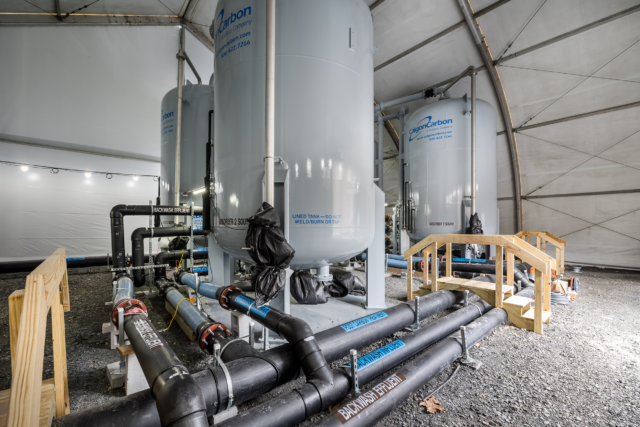How a NY Town Rid Its Drinking Water of Forever Chemicals in Four Months

LaBella’s Aztech Environmental team designed, procured, and installed a PFAS treatment system quickly and cost-effectively.
Perfluoroalkyl substances (PFAS) are a group of over 4,700 compounds used in the manufacturing of nonstick and waterproof coatings, personal products, and fire suppression foams commonly found in airports or air force bases. These long molecular chain fluoride and carbon chemicals are resilient and exposure has been linked to many health risks. Federal oversight with clearly defined “safe” and “unsafe” thresholds has been absent, leading many states to set their own standards.
For local government officials and decision makers, recent media coverage of the issue has created a need for some high school chemistry – parts per trillion, compounds, molecular chains, adsorption, and absorption are all commonly used terms. As films like Dark Waters or Erin Brockovich remind us, no one wants to get this stuff wrong.
Unfortunately, PFAS chemicals – also known as “forever chemicals”– are still considered an “emerging contaminant.” That means regulatory consensus remains elusive. While many means and methods for treatment are being discussed, it’s hard to know what’s proven to work. Because of these factors, our recent experience with the Town of New Windsor, New York, is of interest to many grappling with this issue. Our team designed, procured, and installed a PFAS treatment system for the Town of New Windsor in only four months.
The Town of New Windsor utilizes three groundwater wells for water supply (the largest yielding wells in the state of NY). The well water is treated by a two-year-old water filtration plant called Butterhill Wells, which was averaging three million gallons per day to service 27,000 customers. In May 2019, the water tested positive for PFAS, and soon thereafter, the New York Department of Environmental Conservation (NYSDEC) stepped in and the Town was forced to turn to an alternate water supply, the Catskill Aqueduct.
Officials quickly realized they were on the clock when it came to solutions for the Butterhill plant. A planned maintenance closure of the Catskill Aqueduct was scheduled for November 2019, and the aqueduct had just become the Town’s primary water source. LaBella’s Aztech Environmental team was selected by NYSDEC to develop an effective solution to the contamination. Our team turned to one of the most reliable treatment technologies available – carbon.
Granular activated carbon (GAC) has long been used in water treatment because of its ability to adsorb (bind to the outside of the carbon, not be absorbed by it) most chemical compounds, while allowing clean water to pass through. In New Windsor, our system consisted of ten-foot diameter, 20,000-pound carbon units, which allowed Butterhill to produce 1,500 treated gallons per minute, for 2.16 million gallons per day (the balance of the supply was provided by smaller, uncontaminated supply wells).
Following site mobilization, construction, testing, and backwashing, the GAC treatment system was brought online in November 2019. In December, we added a tensioned fabric building, propane tanks, and heaters to keep the system operational throughout the winter months. All in all, the Butterhill treatment plant was back online and producing water with undetectable PFAS contamination in only four months. Given the need for an emergency treatment facility, our team turned to carbon, which is readily available and easy to procure.
Other methods of treatment include using an ion exchange resin, which offers some advantages and trade-offs. Whereas carbon will adsorb most organics, ion exchange can be tailored to adsorb only certain compounds. This tailoring of treatment can extend the life of the treatment system and reduce media change outs. Resin vessels can also have a smaller footprint due to the lower residence time than carbon. Resin is, however, more costly than carbon and some resins cannot be regenerated and will require thermal destruction. Every water stream has its own constraints and all of the factors, including budget, need to be taken into account when choosing a treatment method and designing the plant.
Regardless of whether a carbon or resin treatment is selected, it is possible to treat your PFAS-contaminated water supply at the plant with a system like Butterhill’s. LaBella’s Aztech Environmental group was able to design, build, and test that system utilizing our in-house services. In other instances, Aztech has collaborated with town consultants and engineers to design and construct treatment systems. Available funding may depend on the source of contamination; in New Windsor, contamination culpability questions continue while the State of New York currently funds the project. Cost recovery will commence after the responsible party is determined.
Cities and towns located near potential PFAS sources should be testing for contamination regularly and proactively. Depending on your treatment plant and contamination levels, some cities and towns may elect to seek uncontaminated water sources elsewhere. However, cost-effective treatment is possible, and will likely become more refined with each community that tackles this challenge.
*This article was featured in the April issue of American City & County Magazine. For more technical content, look for articles about our PFAS treatment system in upcoming issues of Water & Wastes Digest, Treatment Plant Operator, and WaterWorld.